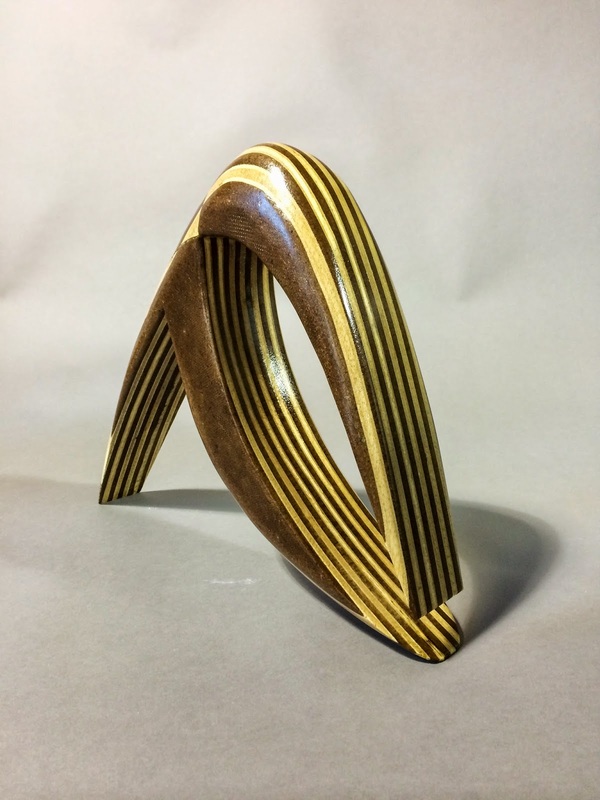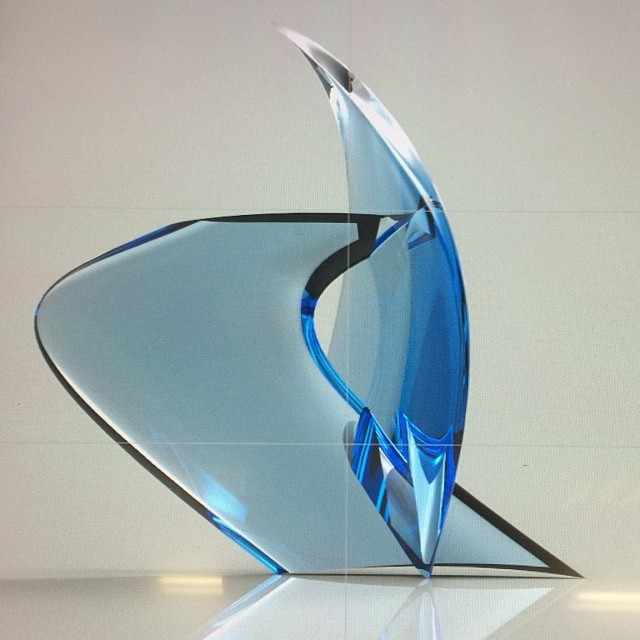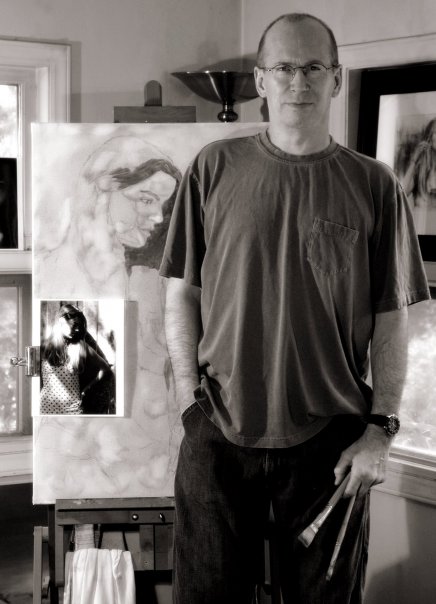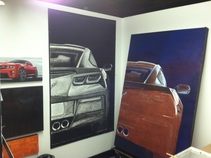Landfall Exhibit Opening ReceptionSavannah College of Art and Design is holding their annual Summer Sales exhibition in the Gutstein Gallery. The show features multidisciplinary works by faculty, alumni, and current students. Kent, a SCAD Alumni, will have one new shaped canvas in the show. Landfall opened on June 15th, and will be open until September 15th. The Gutstein Gallery is located on Broughton street in the heart of Savannah's downtown shopping district. The Gallery has limited viewing hours, so be sure to check before you go. The opening reception is on June 26th, from 6-7:30PM, and will serve free drinks and hors-d'oeuvres.
1 Comment
Prior to graduating SCAD, each Painting major is presented with the challenge of putting on a BFA group exhibition. inter- will open May 2nd, and feature large-scale artwork by artists Ann Haley, Mirielle Jefferson, and Tim Kent.
May 2 - 6. 2014 Opening Reception May 2nd 2014 6-9 PM The exhibition will open on the first friday of May . Food and beverage provided at the opening reception. For more info and news updates check : Exhibition Website I just finished my Sculpture 250: Digital applications in Sculpture class taught by professor Andrew F. Scott at SCAD. Head over to the course blog site to view my in progress pictures, as well as write ups on each process used. Be sure to check out work by other artists too ! An Advanced sculpture 450 class is available at SCAD next quarter which I will be in, so more blog updates will follow !
Digital Sculpture 250 Blog Website Tim Kent's posts on the blog website Hope every one has a great spring break! Tim Be sure to check out Andrew f. Scott's SCAD digital sculpture blog to see posts from Tim Kent Art and other artists in the class. Art work includes 3D printing, laser cutting, CNC milling, and much more!
William Rose May 24th, 2013 I recently had the opportunity to interview local Kansas City artist, William Rose. More of Rose's work can be seen on his artist's website, www.williamroseart.com , or at his studio above the Leedy Volkus Art Center. Tim Kent: What is your first memory of realizing when you wanted to become an artist? William Rose: I always loved art. I have enjoyed going to museums for a long time, but I never realized that I had the talent to create art myself. I was forty years old before I drew my first face. Once I discovered I could draw, I started going to unguided open model sessions at The Kansas City Art Institute. I aIso started reading a lot of books on art. I found out I was naturally utilizing the techniques that the books mentioned. For example, focusing on shapes, or light relationships, rather than trying to specifically draw a nose, or an eye. That’s when I figured out I wasn’t so weird after all. TK: Did you go to school initially for art or did you start your education in a different area? WR: Initially I went to Ball State University in Indiana for a Bachelor in Business Administration. Then I went to Kansas University for an MBA, but never finished because it was essentially all the same information I had already learned in my undergrad. I did some photography on my own while I was in school, but I never took an art course. TK: What caused the change? WR: I used to coach basketball and softball. One evening following a trip to watch a KU softball game, I picked up my daughters sketchpad and tried sketching an image of a softball player. To my surprise and my family's – it looked just like her. A steady stream of requests to draw portraits – mostly sports related – soon followed. That led to a portrait of Tony Gonzalez that’s in The Granfalloon restaurant on the Plaza. TK: How do you decide on your medium? WR: I started out with graphite sketches, and then when I started entering juried shows and competitions I expanded to charcoal. I started to explore watercolor but it wasn’t the right medium; I was trying to use it like oil paint rather than the natural loose and flowing qualities that watercolor is used for. I always wanted to try oil paint but I was a little intimidated when I started reading up on all the rules; fat over lean, transparent and opaque paint, etc.. I’m a perfectionist; I don’t like to mess things up. But I’ve been working with oil on canvas for about 6 years now. TK: Did you ever “mess up” any of your paintings? WR: I have messed up two before. I got caught up in the details in a few spots, causing them to resemble photographs too much for my liking. I had to throw them away. Not that they were bad, but they aren’t something I would want floating around when I’m gone. I like to think about my legacy, and I don’t want someone 50 years from now pulling out one of my earlier works and saying, “look at this William Rose – it kind of sucks and he probably should have tossed it.” TK: How do you make your decision on the scale of your work?
WR: I’m currently working on one that is 7x5 feet. I like to paint big for greater impact. My collectors are looking for something that makes their guest’s jaws drop when they enter the room - that won't usually occur with a small landscape designed to match the couch. TK: How do you come up with ideas for your art? WR: I like people. I like being around them, talking with them, and I like to paint them. My work has a lot to do with the eyes. I like the way just the slightest changes in the squinting of the eyes or shift in an eyebrow can dramatically alter the emotional impact of a face. Sometimes I know exactly what kind of lighting, color and composition I’m going for, but other times I’ll just go do a shoot without a specific project or concept in mind, and come back with 1000 images. Then I search through the images looking for something that jumps out and grabs me. I might use 10 to 30 images for a given painting, and combine the best elements together in the final composition. Right now I have a folder with about 50 images I’m using for my current painting. TK: How do you select your models? WR: When I’m struck by something I like in their face or expression. It’s very personal- I’ve never used professional models. I often paint my friends. My studio assistant, Erin also models for me and I have probably used her in 20-30 drawings and paintings. She appears on the Strathmore 400 series drawing pad cover. I have 3 daughters and many of the friends have graciously volunteered to model for my work as well. TK: Are there any artists that have influenced you? If so, in what way? WR: I like to look at contemporary figurative artists such as Jeremy Lipking, Casey Baugh, and Rocky Hawkins. I’m constantly looking at others work. That’s how artists develop; their work becomes a combination of all those ideas. I have piles of magazines and pictures of work by other artists that I admire for many reasons – it might be composition or color or technique – something grabs me about their work or a specific piece, and I might incorporate some of those ideas into my own work. TK: How do you know when your paintings are done? WR: Oh man, that’s a difficult question. How does any artist? I think it's easier to know when you're done if the piece is closer to photo-realism, but when you combine many abstract elements of color, composition and shape, it becomes much more difficult to decide when to stop. Also working with edges and values are of course critical to a good painting. And that's one of the last things I consider – have I done a good job of creatively working the edges to create the look and focus I'm after? If I make good decisions at this point it can be the difference between a mediocre painting and a great piece of art. TK: What is the best thing about what you do? WR: Being able to do something I love and am truly passionate about. Working for yourself and being your own boss is great. That is coming from someone who worked in the corporate world up until just a few short years ago. Don’t get me wrong; there is still pressure, but it's a different kind of pressure – it makes all the difference when you love what you’re doing. And when I feel like dropping everything and busting outside on a beautiful afternoon for a beer with friends – I just do it. I kind of like that. TK: What’s the worst thing about working with a gallery? WR: There really is no “worst thing.” Galleries are the primary way that an artist like me is able to gain exposure – especially on a national level. TK: What’s one of the biggest pitfalls of young artists? WR: I think the biggest mistake young artists make is thinking because they sculpt or paint or whatever, they can just sit in their basement and tell themselves “people will discover me and want my work.” Having talent is a must. You must produce work that people want to own. But collectors have to find you – see your work. Get out to galleries- talk to other artists; enter juried shows and magazine compositions. Make yourself seen! You have to be a marketer and salesman of yourself to make a living as an artist. I was fortunate to already have that background before I became a professional artist. One of my pieces in the Drawing Works exhibition at the Fahm Hall gallery. Be sure to stop by and check it out- the show will be up from May 1st - May 15th!
|
Tim Kent Art
Blog and Studio Archives
June 2015
Categories |








 RSS Feed
RSS Feed